(Closed) Whitegrass Restaurant – Modern Australian Fine Dining at Chijmes
July 04, 2016

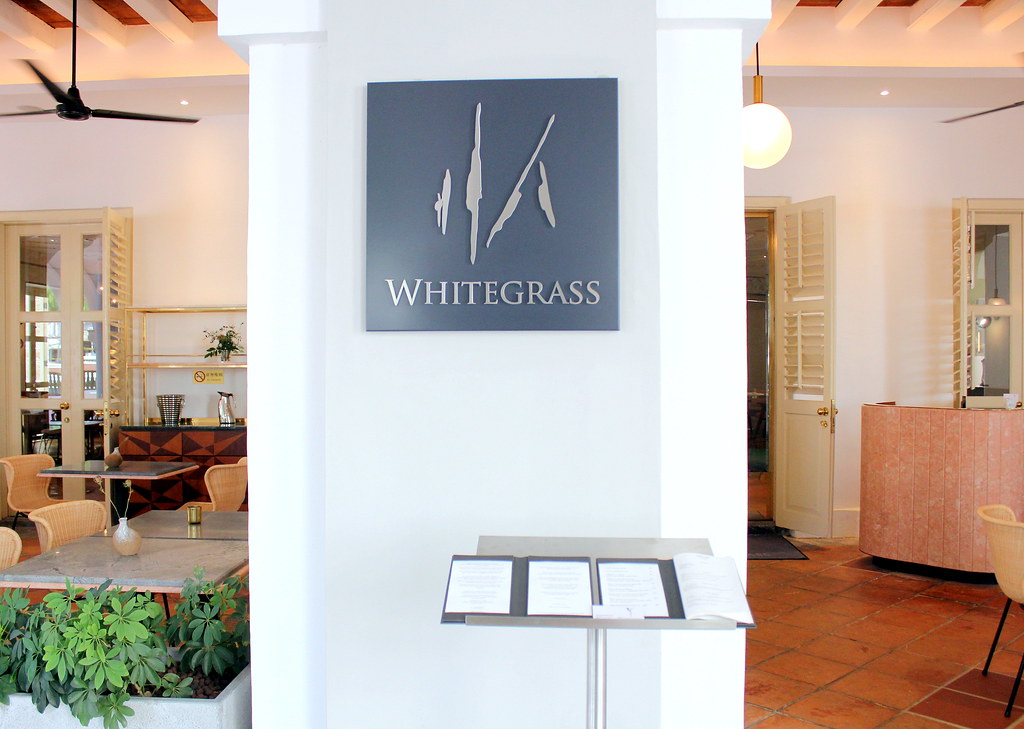
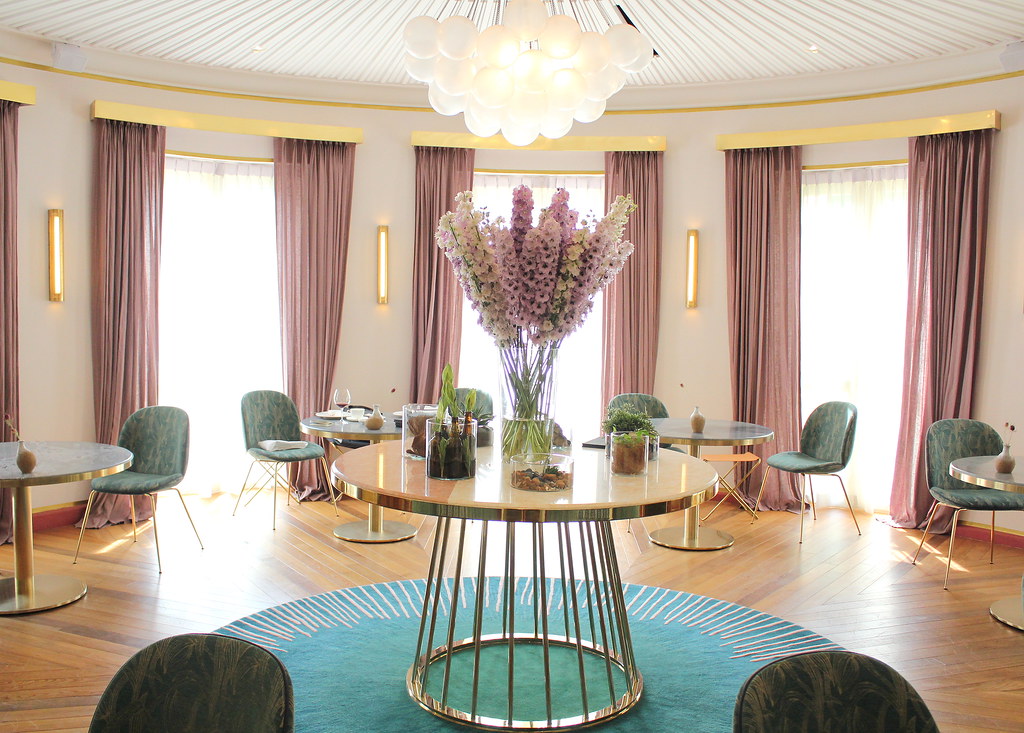
Looking for a serene place for lunch or dinner amidst the bustling city hall precinct? The historic building of Chijmes offer many dining options yet, this particular modern Australian cuisine restaurant stood out for me. The pastel interior of this restaurant exudes a relaxing vibe. Dressed in shades of pinks, forest greens and vibrant blues, the three distinct yet cohesive dining rooms, evoke a sense of home. You won’t feel the pressure to uphold certain etiquette like in other fine-dining restaurants. With a tinge of feminine touch that leans towards hopeless romantics, this restaurant is perfect for holding intimate bachelorette parties, ROM ceremonies, as well as, being appropriate for couples celebrating anniversaries or just a simple date night.
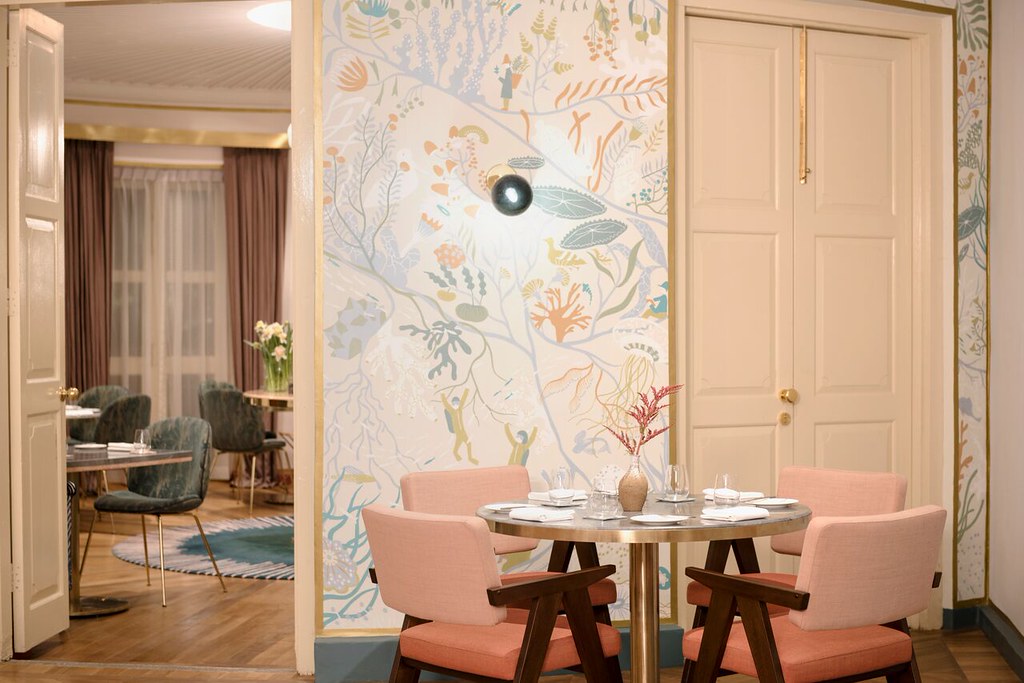
Creative owner-chef, Sam Aisbett, is very meticulous, not just with regards to the taste and appearance of his food. If you look ahead upon entering Whitegrass restaurant, you’ll be enchanted by a wall mural depicting Chef Sam’s love for the nature and its raw beauty. The mural illustrates some of Chef Sam’s personal experiences in obtaining sustainable ingredients and seafood that he uses in his kitchen. Can you spot him embarking on foraging trips to the woods, beaches and mountains, gathering pine mushrooms, chickweed and fennel?
The hand-painted mural is aligned to the name of the restaurant – Whitegrass – which represents the omnipresence of nature; the idea that nature is free of geographical limitations. On the other hand, “Whitegrass” also represents a blank slate and a fresh start for the young Australian chef. Chef Sam’s interpretation of Modern Australian cuisine is a true reflection of his personality and culinary style, combining carefully sourced native Australian ingredients, local Asian produce and Japanese influences.
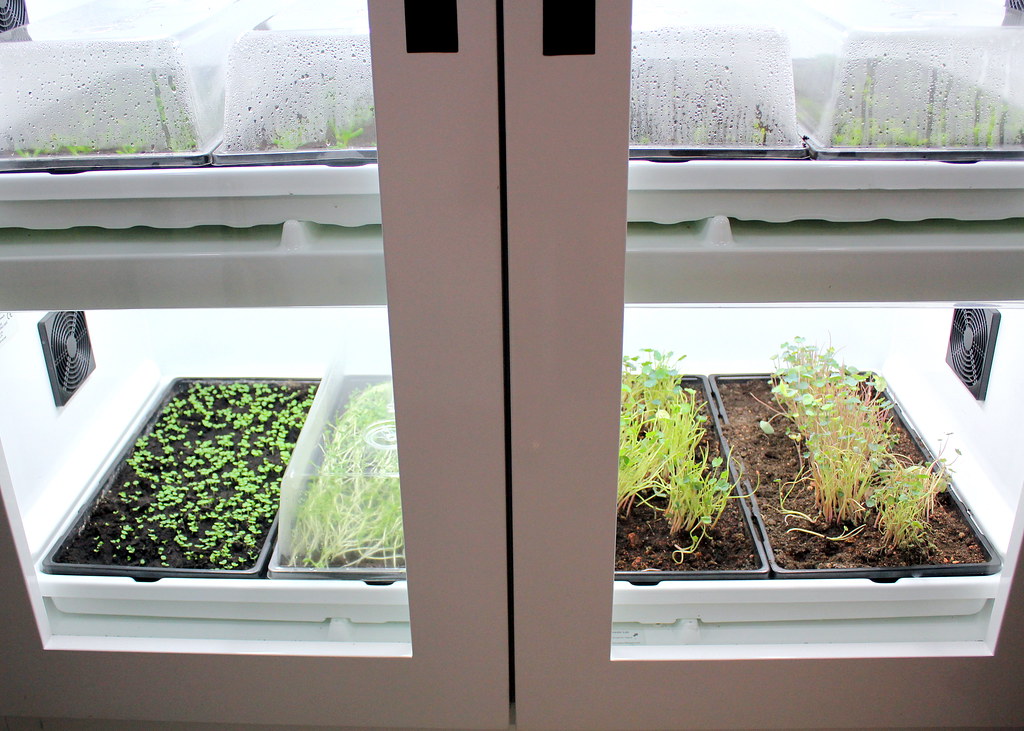
Chef Sam’s love for food developed since he was a child. Born to a family of butchers and citing his mother as one of his greatest culinary influences, he was inspired by her natural talent in the kitchen. Having worked for two of Australia’s leading chefs – Peter Gilmore and Tetsuya Waku – Chef Sam’s creations showcases the inherent beauty and purity of the finest seasonal produce and incorporates differing textural elements into a dish. Chef Sam has even begun to experiment with urban farming inside the restaurant, cultivating cress, nasturtium, pea sprouts and sea succulents as garnishes for his elaborate plates.
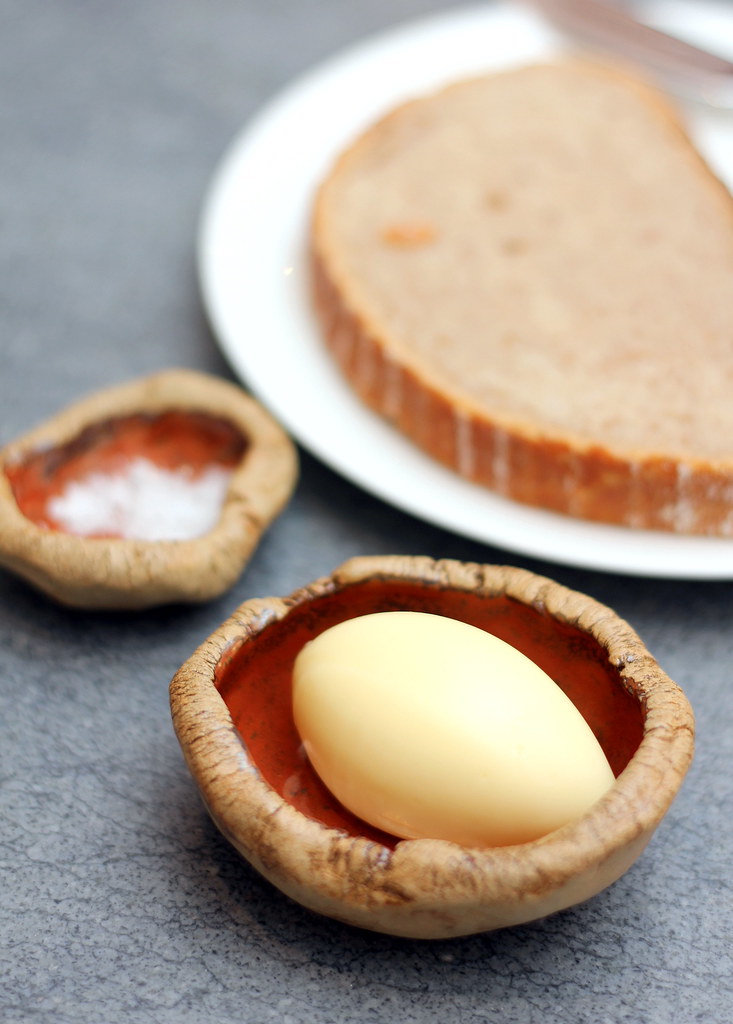
To kickstart lunch, sourdough bread was served. Freshly baked in-house, the sourdough bread-making process takes up to three days from beginning to end. Served with a quenelle of Echire butter from France and Australian sea salt sourced from a family-run sea salt farm in South Australia, you can’t stop at one slice. I always felt that butter sourced from overseas, especially European countries, tastes much richer than the ones we have in Singapore!
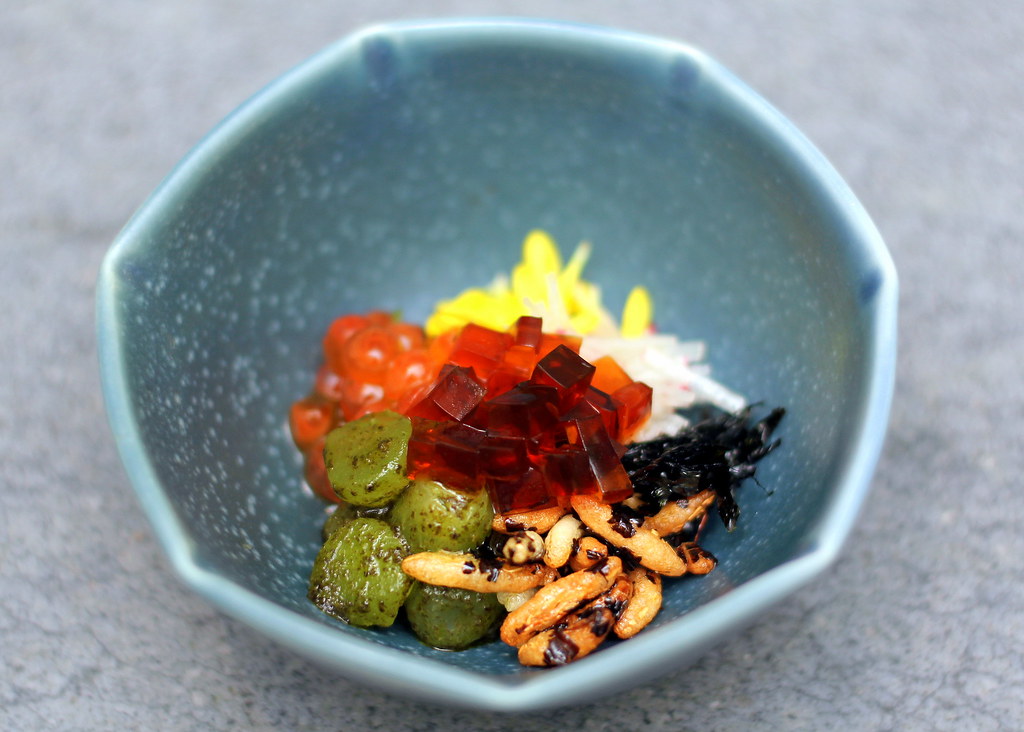
At the mention of Bibimbap, most of us would immediately imagine the colourfully-filled hot stone-pot. However, the Amuse Bouche Bibimbap served at Whitegrass is distinctively different. Chef Sam made use of Nori cream, made with crème fraiche and nori. The colourful ingredients, made to resemble an actual bibimbap, consists of compressed cucumber sphere, cured trout roe, chrysanthemum petals, puffed wild rice, toasted nori, cherry bell radish and dashi jelly. I simply love the mix of crunchy and jelly-like textures, especially when the cured trout roe bursts juicily in my mouth.
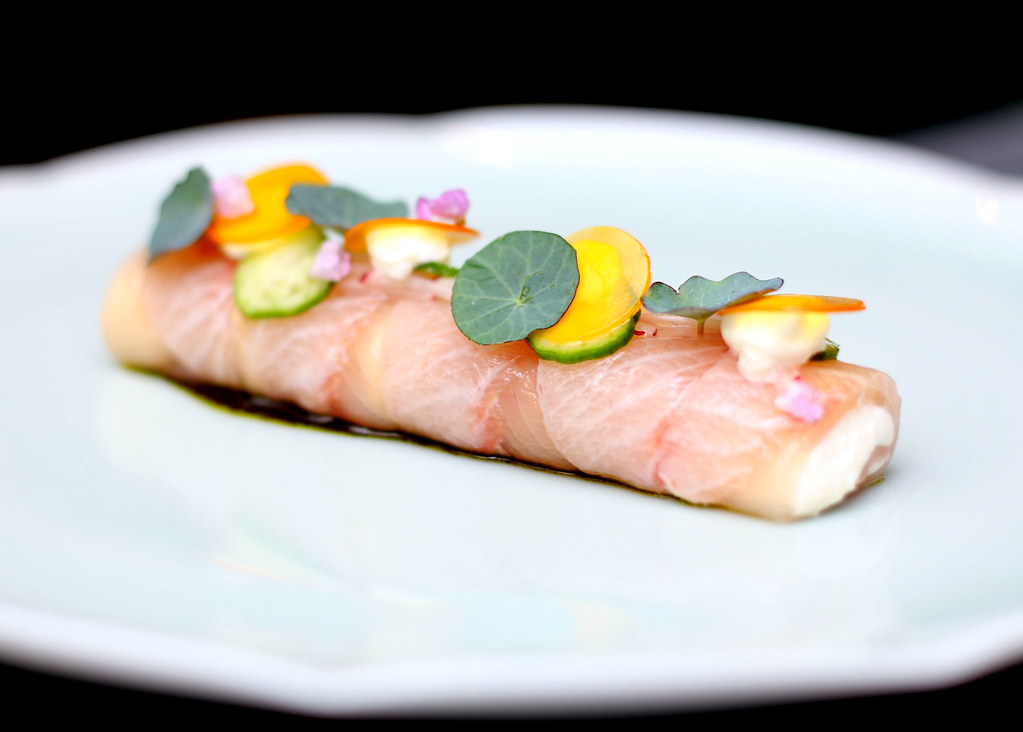
Being a huge fan of sashimi, I was ecstatic when the sashimi of yellowtail amberjack was served. Caught in the Japanese region, Chef Sam sliced the fresh yellowtail amberjack delicately and dressed it in a white soy marinade with kombu, bonito and bonito oil. The fish encases a horseradish cream made simply by incorporating horseradish, crème fraiche and sea salt. Egg yolks are salted for three days, rolled out and cut into discs. You can tell how much thought Chef Sam has put into creating a dish, just looking at the plating. Doesn’t the yellowtail amberjack sashimi look beautifully decorated with the help of Japanese red radish, Japanese baby cucumber, shiso flowers, nasturtium leaves, egg yolk discs and a toasted seaweed oil infused with dry Japanese nori?
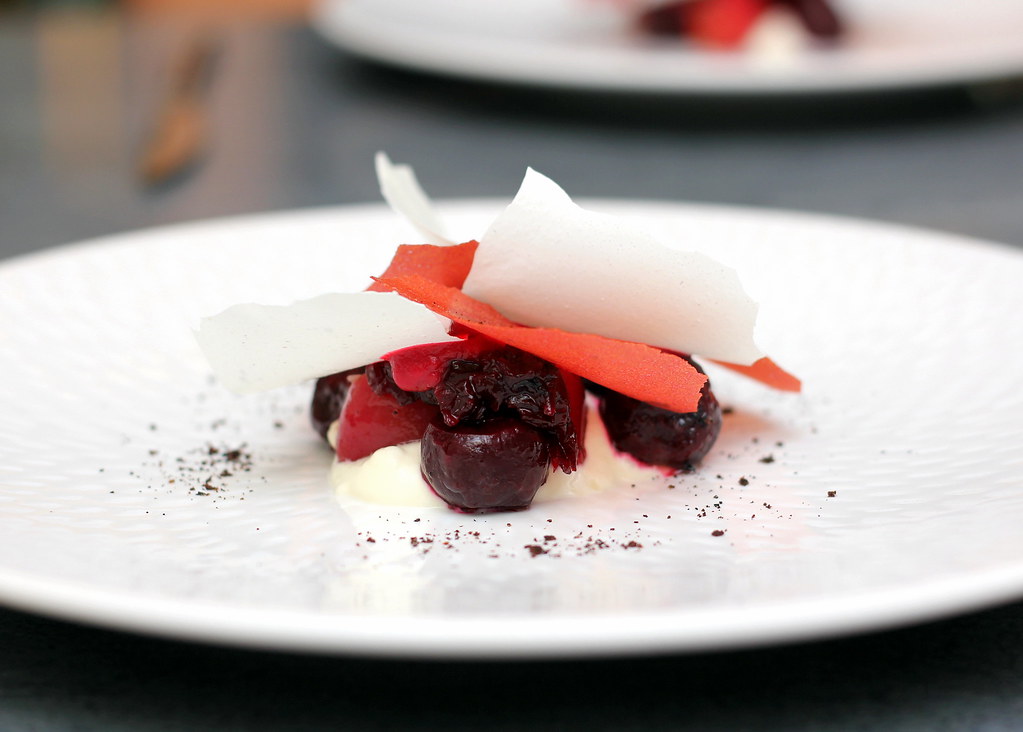
You haven’t seen the prettiest dish yet! This is a salad of slow roasted young beetroots, smoked eel and rosella jam. Target and Chioggia beetroots sourced from Victoria, Australia, are used and the beets are simply roasted, peeled and dressed with muscatel vinegar while warm. The beetroots sit on a bed of cultured cream with smoked eel from Holland. Rosella jam is made with a hibiscus flower originally from Africa but sourced locally in Singapore. The flowers are cooked down with sugar, sherry and sherry vinegar and you’ll get the end product – rosella jam! Garnished with a duo of crisps for an additional layer of texture, the first crisp is made from beetroot juice and barley while the second crisp is made from sushi rice and eel skin pepper. This is so impressive! Personally, I love the crisps! The dish is topped with grated Australian mountain berry from Tasmania.

My lunch got better and better when the Western Australia marron arrived. Freshwater marron from Western Australia is poached lightly in butter before serving with desert lime, picked cucumber that is pickled in-house in sushi rice vinegar and grilled cucumber seared on a plancha, young garlic cream, breakfast radish and beach bananas. Are you going, “HUH?!” Basically, beach bananas aka salty fingers are edible leaves that are grown by Chef Sam in his urban cultivator. The dish is completed with cucumber flowers.
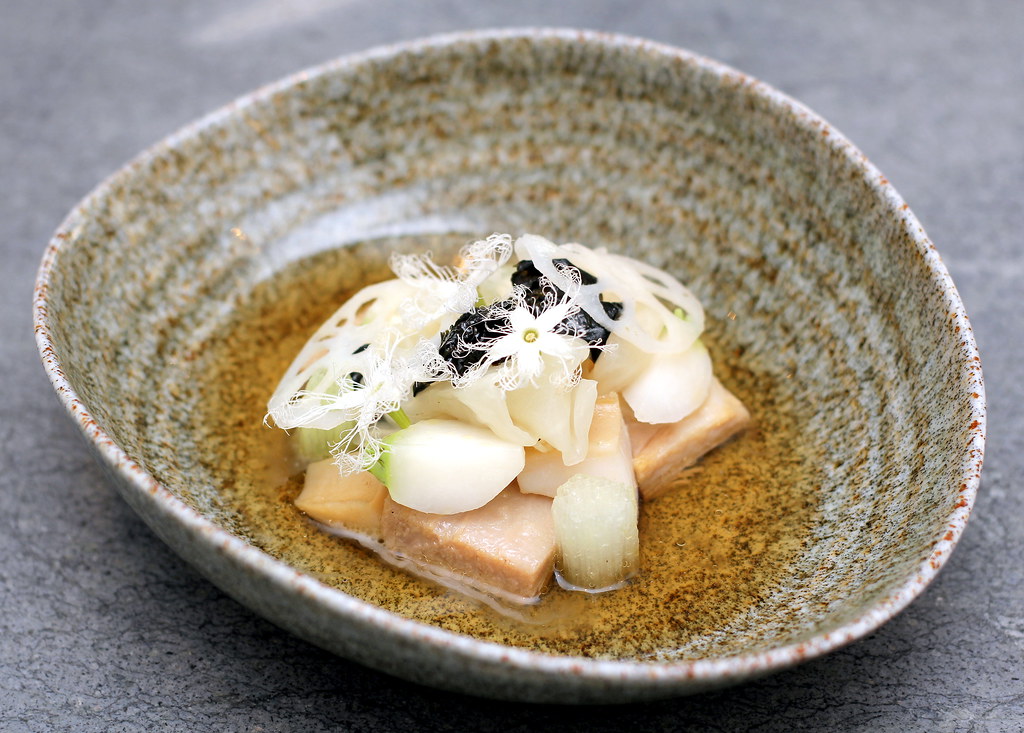
Here comes the highlight of my lunch – slow cooked Mangalica pork jowl and jade tiger abalone with fermented cabbage! Mangalica pork comes from a special breed of woolly pig from Hungary! It is slow cooked in a salted brine overnight and gently poached in clarified butter before serving with jade tiger abalone from Victoria, Australia, that is poached similarly in clarified butter. The pork was velvety smooth and melts in your mouth. It absorbs the flavourful seaweed and pork broth poured tableside from a cast iron tea pot so well. The lightness of the broth cuts through the richness of the pork. Combined with fermented cabbage, a Japanese variety of turnips sourced from Melbourne and garnishes such as blanched fiddlehead ferns from Japan, hasu-imo (inner stalks of Japanese lotus yam) and white snake gourd flowers, the overall taste sends you straight to foodie heaven!
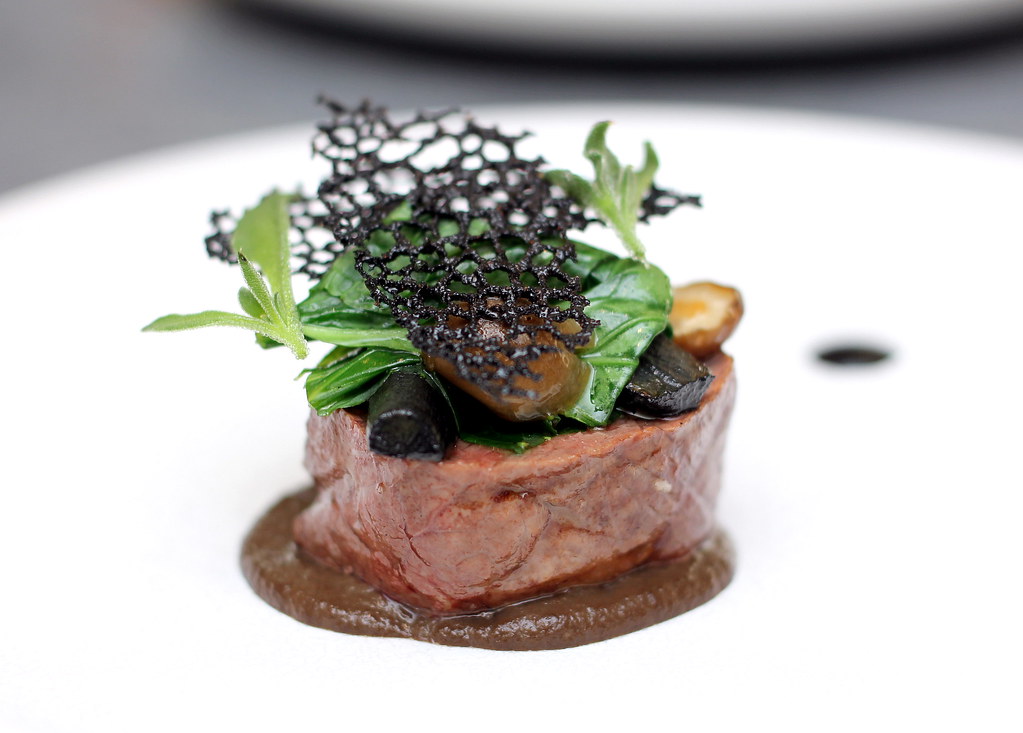
The final dish before desserts were served was this grass-fed Black Angus beef tenderloin from the Scottish Highlands. After being cooked over bincho-tan charcoal (white charcoal), the beef is rubbed with a high quality, lightly roasted white sesame oil and sits on a fermented mushroom puree that is made with Swiss brown mushrooms and fermented shitake mushrooms. It is served with wilted wasabi leaf, salsify shimeji mushroom caps, ice plant tips and a crispy rice lace that is seasoned with charcoal and shitake powder. Done medium-rare, the beef was tender and succulent.
Here’s a surprising fact! This beef was specially curated to complement a rare 20-year-old soy sauce called Kamebishi Shoyu. The soy sauce is from Kagawa prefecture in Japan and made by a family-owned company that has been around since 1753. It is one of the oldest soy sauce companies in Japan and the only one that is making soy sauce the traditional way using mushiro-koji. The soy is left to age in 200-year-old cedar barrels. Chef Sam specifically sourced for this soy sauce and built a dish around it! It is served unadorned to accompany the meat. Due to its super strong flavour, I recommend just a teeny weeny dip!
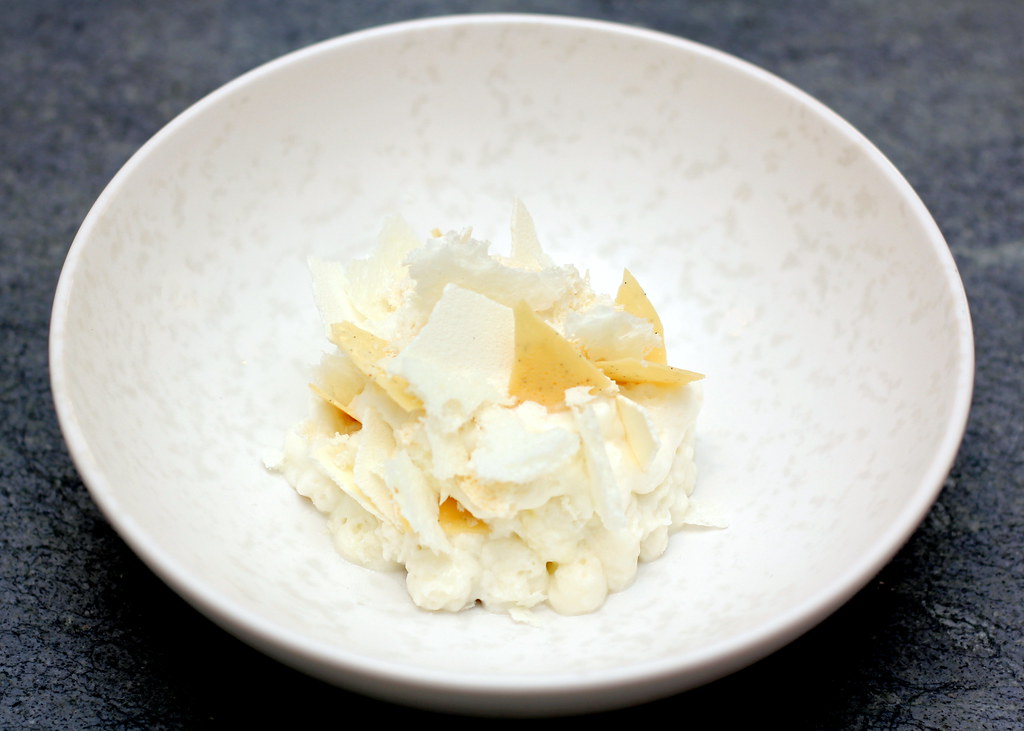
Desserts are a girl’s best friend! At Whitegrass, Chef Sam has infused local flavours from tropical fruits into his ice cream. Inspired by his visits to our local markets, Chef Sam pairs a feathery light coconut mousse with a jackfruit ice cream and ginger cake. I really enjoyed the morsels of ginger sponge that cuts through the fruits’ sweetness and brings an unexpected punch to the combination of sweet, tropical flavours. Once again, you get many different textures in a dish, which takes the form of milk biscuits, meringue, caramelized almonds, macarons, sugar shards and young coconut flesh. Edible flowers is used to beautify the dessert.
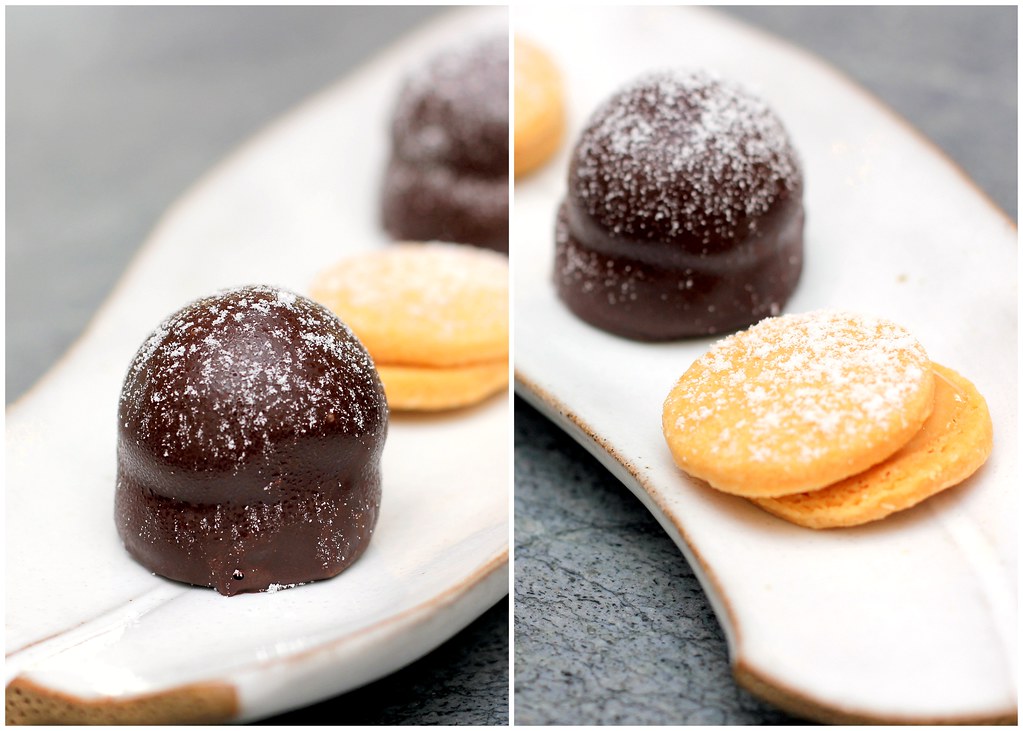
Besides the young coconut mousse with jackfruit ice cream, Chef Sam also created petit fours – Manjar blanco Alfajor and raspberry snowball. The former is created based on both Chef Sam and head chef Diego’s tributes to their home country. Head chef Diego is from Peru and created the delicate cookie sandwich filled with Dulce de Leche, made with condensed milk, caramelized sugar and vanilla bean. The latter was inspired by Arnott’s Royals Chocolate. The snowball comprises of a layer of chocolate brownie with almonds, followed by marshmallow with raspberry jam. It is then coated with 66% Valhona dark chocolate. What a sinfully sweet indulgence!
At Whitegrass, you’ll be able to gain an unforgettable experience putting all your five senses to good use! I was extremely awed by the gorgeously curated dishes and my tastebuds “struck gold”. Combined with lively and personable service in a relaxed environment, this is a restaurant worth returning to if you want to feel at ease while enjoying elegant and refined food, no matter the occasion. 2 course lunch menu costs $48++, 3 course lunch menu costs $64++ and 5 course lunch menu costs $135++. 5 course dinner menu costs $170++. Optional wine match at additional $90++. 8 course dinner menu costs $255++ and optional wine match at additional $125++.
Whitegrass Restaurant
Address: 30 Victoria Street, #01-26/27, Chijmes, Singapore 187996
Phone: +65 6837 0402
Website: www.whitegrass.com.sg
Opening Hours: Wed-Sat (lunch) 12pm to 2pm. Tue-Sat (dinner) 6.30pm to 9.30pm. Tue-Sat (bar) 5.30pm to 11.45pm. Closed on Sundays and Mondays.



